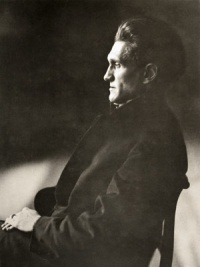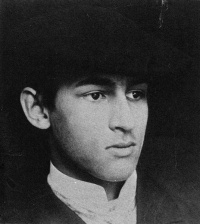Stefan George: Difference between revisions
Modified one of the categories of the page |
|||
| (12 intermediate revisions by 2 users not shown) | |||
| Line 6: | Line 6: | ||
==Stefan George and Maximilian Kronberger== | ==Stefan George and Maximilian Kronberger== | ||
[[File:536px-Maximilian Kronberger (1888-1904).JPG|thumb|200 px|Maximilian Kronberger]] | [[File:536px-Maximilian Kronberger (1888-1904).JPG|thumb|200 px|Maximilian Kronberger]] | ||
George's "[[pederasty]]"<ref>Robert E. Norton, ''Secret Germany: Stefan George and his Circle'' (Cornell University Press, 2002) page 354</ref> is reflected in works such as ''Algabal'' and the love poetry he devoted to a gifted adolescent of his acquaintance named '''Maximilian Kronberger''',<ref name="glbtq">{{citation |url= | George's "[[pederasty]]"<ref>Robert E. Norton, ''Secret Germany: Stefan George and his Circle'' (Cornell University Press, 2002) page 354</ref> is reflected in works such as ''Algabal'' and the love poetry he devoted to a gifted adolescent of his acquaintance named '''Maximilian Kronberger''' (April 15, 1888 — April 16, 1904),<ref name="glbtq">{{citation |url= |last=Palmer |first=Craig B. |title=George, Stefan |periodical=glbtq.com |year=2002 |accessdate=2007-11-23}}.</ref> whom he called "Maximin", and whom he identified as a manifestation of the divine. Maximin was around 14 when he met George.<ref>[http://www.johncoulthart.com/feuilleton/2014/04/24/maximin-ein-gedenkbuch-by-stefan-george/ Maximin: Ein Gedenkbuch]</ref> The relevance of George's sexuality to his poetic work has been discussed by contemporary critics, such as Thomas Karlauf and Marita Keilson-Lauritz.<ref>See for example, Marita Keilson-Lauritz, "Ubergeschlechtliche Liebe: Stefan George's Concept of Love" (Rieckmann, ed ''A Companion to the Works of Stefan George'' (Camden House, 2005)</ref> | ||
Maximin came to the attention of Stefan George in Munich in 1903 (according to some sources, in March 1902; others cite 1901 as the date of their original meeting); | Maximin came to the attention of Stefan George in Munich in 1903 (according to some sources, in March 1902; others cite 1901 as the date of their original meeting); Maximin died unexpectedly of meningitis, on the day after his 16th birthday. He was "idealized [by George] to the point of proclaiming him a god, following his death... the cult of 'Maximin' became an integral part of the George circle’s practice…" <ref name=Fernbach>David Fernbach, 'Prophet‑pariah', ''New Left Review'', vol. 18 (November–December 2002).</ref> The ''Maximin-Erlebnis'' certainly provided George with inspiration for his work in subsequent years. | ||
Thirty-three of Kronberger’s poems are included in the posthumously published collective volume, ''Maximin: Ein Gedenkbuch'' (now a rare book).<ref name=George>[[Stefan George]], comp., ''Maximin: Ein Gedenkbuch'' , with illustrations (''Ausschmueckung'') by [[Melchior Lechter]] (Berlin, Blätter für die Kunst, 1907); includes a portrait photograph of Maximin taken by Stefan George; limited edition of 200 numbered copies (to be consulted at Yale University’s Beinecke Rare Book and Manuscript Library in New Haven, Connecticut).</ref> | Thirty-three of Kronberger’s poems are included in the posthumously published collective volume, ''Maximin: Ein Gedenkbuch'' (now a rare book).<ref name=George>[[Stefan George]], comp., ''Maximin: Ein Gedenkbuch'' , with illustrations (''Ausschmueckung'') by [[Melchior Lechter]] (Berlin, Blätter für die Kunst, 1907); includes a portrait photograph of Maximin taken by Stefan George; limited edition of 200 numbered copies (to be consulted at Yale University’s Beinecke Rare Book and Manuscript Library in New Haven, Connecticut).</ref> | ||
| Line 14: | Line 14: | ||
==Bibliography== | ==Bibliography== | ||
* | * 1890: ''Hymnen'' ("Hymns"), 18 poems written reflecting Symbolism; dedicated to Carl August Klein; limited, private edition<ref name=sgewb>Stefan George, ''Poems'', Trans. & Ed. Carol North Valhope and Ernst Morwitz. (New York: Pantheon, 1946).</ref> | ||
* | * 1891: ''Pilgerfahrten'' ("Pilgrimages") limited, private edition<ref name=sgewb/> | ||
* | * 1892: ''Algabal'' (1892); illustrated by Melchior Lechter; limited, private edition<ref name=sgewb/> | ||
* | * 1897: ''Das Jahr der Seele'' ("The Year of the Soul")<ref name=sgewb/> | ||
* | * 1899: ''Teppich des Lebens'' ("The Tapestry of Life")<ref name=sgewb/> | ||
* | * 1900: ''Hymnen, Pilgerfahrten, and Algabal'', a one-volume edition published in Berlin by Georg Bondi which first made George's work available to the public at large<ref name=sgewb/> | ||
* | * 1901: ''Die Fibel'' ("Primer"), poems written from 1886-1889<ref name=sgewb/> | ||
* | * 1903: ''Tage und Taten'' ("Days and Works"; cf. Hesiod's ''Works and Days'')<ref name=sgewb/> | ||
* | * 1907: ''Der siebente Ring'' ("The Seventh Ring")<ref name=sgewb/> | ||
* | * 1913: ''Der Stern des Bundes'' ("The Star of the Covenant")<ref name=sgewb/> | ||
* | * 1917: ''Der Krieg'' ("The War")<ref name=sgewb/> | ||
* | * 1928: ''Das neue Reich'' ("The Kingdom Come")<ref name=sgewb/> | ||
==Studies== | ==Studies== | ||
| Line 47: | Line 47: | ||
==External links== | ==External links== | ||
*[http://www.johncoulthart.com/feuilleton/2014/04/24/maximin-ein-gedenkbuch-by-stefan-george/ Maximin: Ein Gedenkbuch] | |||
*[https://en.wikipedia.org/wiki/Stefan_George Stefan George (Wikipedia)] | |||
*[https://en.wikipedia.org/wiki/Maximilian_Kronberger Maximilian Kronberger (Wikipedia)] | |||
{{DEFAULTSORT:George, Stefan}} | {{DEFAULTSORT:George, Stefan}} | ||
[[Category:1868 births]] | [[Category:1868 births]] | ||
[[Category: | [[Category:20th-century boylovers]] | ||
[[Category:Poets]] | [[Category:Poets]] | ||
[[Category: | [[Category:German literature]] | ||
[[Category:German people]] | |||
Latest revision as of 18:03, 21 January 2019

Stefan Anton George (July 12, 1868 - December 4, 1933) was a German poet, editor, and translator.
Stefan George and Maximilian Kronberger

George's "pederasty"[1] is reflected in works such as Algabal and the love poetry he devoted to a gifted adolescent of his acquaintance named Maximilian Kronberger (April 15, 1888 — April 16, 1904),[2] whom he called "Maximin", and whom he identified as a manifestation of the divine. Maximin was around 14 when he met George.[3] The relevance of George's sexuality to his poetic work has been discussed by contemporary critics, such as Thomas Karlauf and Marita Keilson-Lauritz.[4]
Maximin came to the attention of Stefan George in Munich in 1903 (according to some sources, in March 1902; others cite 1901 as the date of their original meeting); Maximin died unexpectedly of meningitis, on the day after his 16th birthday. He was "idealized [by George] to the point of proclaiming him a god, following his death... the cult of 'Maximin' became an integral part of the George circle’s practice…" [5] The Maximin-Erlebnis certainly provided George with inspiration for his work in subsequent years.
Thirty-three of Kronberger’s poems are included in the posthumously published collective volume, Maximin: Ein Gedenkbuch (now a rare book).[6]
Bibliography
- 1890: Hymnen ("Hymns"), 18 poems written reflecting Symbolism; dedicated to Carl August Klein; limited, private edition[7]
- 1891: Pilgerfahrten ("Pilgrimages") limited, private edition[7]
- 1892: Algabal (1892); illustrated by Melchior Lechter; limited, private edition[7]
- 1897: Das Jahr der Seele ("The Year of the Soul")[7]
- 1899: Teppich des Lebens ("The Tapestry of Life")[7]
- 1900: Hymnen, Pilgerfahrten, and Algabal, a one-volume edition published in Berlin by Georg Bondi which first made George's work available to the public at large[7]
- 1901: Die Fibel ("Primer"), poems written from 1886-1889[7]
- 1903: Tage und Taten ("Days and Works"; cf. Hesiod's Works and Days)[7]
- 1907: Der siebente Ring ("The Seventh Ring")[7]
- 1913: Der Stern des Bundes ("The Star of the Covenant")[7]
- 1917: Der Krieg ("The War")[7]
- 1928: Das neue Reich ("The Kingdom Come")[7]
Studies
- Breuer, Stefan (1996). Ästhetischer Fundamentalismus: Stefan George und der deutsche Antimodernismus. Darmstadt: Primus.
- Capetanakis, D., 'Stefan George', in Demetrios Capetanakis A Greek Poet In England (1947), p. 72-89
- Frank, Lore & Sabine Ribbeck (2000). Stefan-George-Bibliographie 1976-1997. Mit Nachträgen bis 1976. Auf der Grundlage der Bestände des Stefan-George-Archivs in der Württembergischen Landesbibliothek. Tübingen: Niemeyer.
- Goldsmith, Ulrich (1951). Stefan George and the theatre. New York: The Modern Language Association (PLMA Publications LXVI:2).
- Goldsmith, Ulrich (1959). Stefan George: A study of his early work. Boulder: University of Colorado Press (University of Colorado Studies Series in Language and Literature 7).
- Goldsmith, Ulrich (1970). Stefan George. New York: Columbia University Press (Essays on Modern Writers).
- Goldsmith, Ulrich (1974). Shakespeare and Stefan George: The sonnets. Berne: Franke.
- Kluncker, Karlhans (1985). "Das geheime Deutschland": Über Stefan George und seinen Kreis. Bonn: Bouvier (Abhandlungen zur Kunst-, Musik- und Literaturwissenschaft 355).
- Norton, Robert E. (2002). Secret Germany: Stefan George and his Circle. Ithaca, NY: Cornell University Press.
- Schmitz, Victor (1978). Stefan George und Rainer Maria Rilke: Gestaltung und Verinnerlichung. Berne: Wild.
- Rieckmann, Jens (ed.) (2005). A Companion to the Works of Stefan George. Camden House.
- Lacchin, Giancarlo (2006). Stefan George e l'antichità. Lineamenti di una filosofia dell'arte. Lugano: University Words.
- Schefold, Bertram. (2011). Politische Ökonomie als Geisteswissenschaft. Edgar Salin und andere Ökonomen um Stefan George, in Studien zur Entwicklung der ökonomischen Theorie, XXVI. Edited by Harald Hagemann, Duncker & Humblot
References
- ↑ Robert E. Norton, Secret Germany: Stefan George and his Circle (Cornell University Press, 2002) page 354
- ↑ Palmer, Craig B. (2002), "George, Stefan", glbtq.com.
- ↑ Maximin: Ein Gedenkbuch
- ↑ See for example, Marita Keilson-Lauritz, "Ubergeschlechtliche Liebe: Stefan George's Concept of Love" (Rieckmann, ed A Companion to the Works of Stefan George (Camden House, 2005)
- ↑ David Fernbach, 'Prophet‑pariah', New Left Review, vol. 18 (November–December 2002).
- ↑ Stefan George, comp., Maximin: Ein Gedenkbuch , with illustrations (Ausschmueckung) by Melchior Lechter (Berlin, Blätter für die Kunst, 1907); includes a portrait photograph of Maximin taken by Stefan George; limited edition of 200 numbered copies (to be consulted at Yale University’s Beinecke Rare Book and Manuscript Library in New Haven, Connecticut).
- ↑ 7.00 7.01 7.02 7.03 7.04 7.05 7.06 7.07 7.08 7.09 7.10 7.11 Stefan George, Poems, Trans. & Ed. Carol North Valhope and Ernst Morwitz. (New York: Pantheon, 1946).